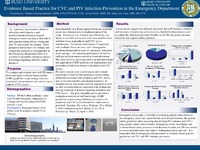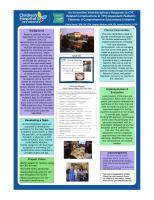Protecting patients against CVC and PIV-related infections: An ED survey
View File(s)
- Author(s)
- Details
-
Marites Gonzaga-Reardon, MSN, APN, CEN, CCNS-BC, marites_b_gonzaga-reardon@rush.edu; Jessica Stults, MSN, RN, CEN; Mary Kay Nuno, BSN, RN, CEN
- Sigma Affiliation
- Non-member
Visitor Statistics
Visits vs Downloads
Visitors - World Map
Top Visiting Countries
| Country | Visits |
|---|
Top Visiting Cities
| City | Visits |
|---|
Visits (last 6 months)
Downloads (last 6 months)
Popular Works for Gonzaga-Reardon, Marites by View
| Title | Page Views |
|---|
Popular Works for Gonzaga-Reardon, Marites by Download
| Title | Downloads |
|---|
View Citations
Citations
Background: As regulatory requirements related to infection control practices and reimbursement continues to expand, emergency nurses can play a vital role in infection prevention before, during, and after IV therapy. Since peripheral intravenous (IV) therapy and central line insertion is often initiated in the Emergency Department (ED), it is essential to determine emergency nurse knowledge regarding infection control practices.
Purpose: The purpose for this study is to examine and evaluate how well Emergency Department (ED) nurses know and apply evidence based practice (EBP) guidelines in preventing infections associated with peripheral and central venous catheter (CVC) access.
Design: This evidence based practice project (EBP) explores how well ED nurses know and apply EBP guidelines in preventing infections associated with peripheral and CVC access through a pre and post survey of registered nurses in an urban Level II academic center Emergency Department. Setting: The study site is a 60 bed urban Level II academic ED in Chicago serving an average of 65,000 patients a year.
Subjects/Participants: The subjects for this EBP project include registered nurses of an urban Level II academic center Emergency Department in Chicago.
Methodology: Institutional Review Board approval from the academic center was obtained prior to the implementation of the study. Permission was obtained from Delahanty and Myers to use their survey tool with some modifications added to focus on peripheral and CVC access maintenance. The survey tool contains 15 questions with multiple choice answers; and 3 demographic questions that pertain to years of experience, education level and age. The voluntary participation of staff in both pre- and post-survey will serve as assumed consent. The study involves surveying nurses on their knowledge and application of EBP guidelines on maintenance and prevention of infection related to peripheral and CVC access. Pre-survey results will not only be used to assess and evaluate knowledge of staff on EBP guidelines on preventing infections associated with peripheral and CVC access; but will also be used to develop effective educational resources. Literature review will be used to provide education as well as offer recommendations associated with institutional nursing standards of practice regarding peripheral and CVC access. The post-education survey will provide a comparison analysis of staff knowledge and application of EBP guidelines on preventing infections associated with peripheral and CVC access based from interventions provided.
Results/Outcomes: Survey results suggest that although education and staff training is intuitive and necessary in improving safety practices, hardwiring best practices such of central line infection prevention bundles in the emergency department can greatly decreased infections and improve safety practices. Implications: Emergency nurses play a role in protecting patients from infection. As emergency nurses are exposed to the most recent literature, the improvement of general safety guidelines when accessing and utilizing PIV catheters and CVCs may greatly reduce infection rates. Emergency nurses’ knowledge and evidence based safety practices could decrease hospital and ED cost related to nasocomial infections and improve both patient safety and care.
2014 ENA Annual Conference Theme: Safe Practice, Safe Care. Held at the Indiana Convention Center
Items submitted to a conference/event were evaluated/peer-reviewed at the time of abstract submission to the event. No other peer-review was provided prior to submission to the Henderson Repository, unless otherwise noted.
| Type | Poster |
| Acquisition | Proxy-submission |
| Review Type | Abstract Review Only: Reviewed by Event Host |
| Format | Text-based Document |
| Evidence Level | N/A |
| Research Approach | N/A |
| Keywords | Protecting Patients from Infection; Infections in the ED; Infection Protection |
| Name | 2014 ENA Annual Conference |
| Host | Emergency Nurses Association |
| Location | Indianapolis, Indiana, USA |
| Date | 2014 |
All rights reserved by the author(s) and/or publisher(s) listed in this item record unless relinquished in whole or part by a rights notation or a Creative Commons License present in this item record.
All permission requests should be directed accordingly and not to the Sigma Repository.
All submitting authors or publishers have affirmed that when using material in their work where they do not own copyright, they have obtained permission of the copyright holder prior to submission and the rights holder has been acknowledged as necessary.
Related items
Showing items related by title, author, creator and subjects.
-
Triage patient flow redesign in an urban academic emergency department
Gonzaga-Reardon, Marites; Altman, Patricia; Valentine, Runay; Serafin, Frederick (2015-02-04)Purpose: The purpose of this process improvement project is to evaluate whether the implementation of “Lean approach” interventions in the triage redesign of an urban academic emergency department improves ... -
An innovative interdisciplinary response to CVC-related complications in TPN-dependent pediatric patients: A comprehensive educational initiative
Verret, Gloria; Meehan, Meghan; Parikh, Manisha (2017-06-06)Central line associated bloodstream infections (CLABSIs) are a significant cause of morbidity in medically complex pediatric patients who rely on central venous access for life-saving medications and nutrition. The financial ... -
Testing Peplau's theory of interpersonal relations in nursing using data from patient experience surveys
Hagerty, Thomas A.Patients’ experiences in hospitals are important indicators of quality. Patients’ opinions about their experiences in hospitals are significantly associated with their opinions of those hospitals’ nursing ... -
The changing of ambulatory care: Provision and utilizations as influenced by the Patient Protection and Affordable Care Act
Brom, Heather MarieBackground and Aims: Nurse practitioners (NPs) represent a growing healthcare provider workforce, which is poised to assist with the shortages of physicians and growing demand for healthcare services driven by the Affordable ... -
Nursing implications and findings from a portal activation study of a large healthcare system
Theiss, Mary Anne; Friesen, Mary Ann; Trickey, Amber W.; Krakowski, Kimberly M.; Mook, Patricia J.; Majors, Season M.; Fant, Catherine C.; Cresci, M. Kay (2017-09-25)Collaborative research of patient portal activation was conducted in a large network of hospitals including outpatient and inpatient facilities. The study examined the demographics of those that activated the portal. The ...





